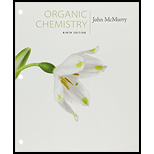
Interpretation:
Given that 2-substituted-2-cyclopentenones are in a base catalyzed equilibrium with their 5-substituted-2-cyclopentenone isomers. Why such analogous isomerization is not observed for 2-substituted -2-cyclohexenones is to be explained.
Concept introduction:
The isomerization of cycloalkenones occurs through an enolate anion formed by the abstraction of acidic hydrogen by the base. Hydrogens on carbon α- to a carbonyl group and those on γ- carbon in a conjugated enone are acidic. If these hydrogens are removed, isomerization will occur. Otherwise isomerization is not possible.
To explain:
Why 2-substituted -2-cyclohexenones are not in a base catalyzed equilibrium with their 6-substituted -2-cyclohexenone isomers like 2-substituted-2-cyclopentenones.
Want to see the full answer?
Check out a sample textbook solution
Chapter 22 Solutions
Student Value Bundle: Organic Chemistry, + OWLv2 with Student Solutions Manual eBook, 4 terms (24 months) Printed Access Card (NEW!!)
- Predict the major products of this reaction: ་ ་ + H NaOH ? Δ excess Note that the second reactant is used in excess, that is, there is much more of the second reactant than the first. If there won't be any products, just check the box under the drawing area instead.arrow_forwardP A student claims the right-hand side of the reaction in the drawing area below shows the product of a Claisen condensation. • If the student is correct, complete the reaction by adding the necessary organic reactants to the left-hand side, and by adding any necessary reagents and reaction conditions above and below the arrow. • If the student is incorrect, because it's not possible to obtain this product from a Claisen condensation, check the box under the drawing area instead. those that will minimize any byproducts or competing • Note for advanced students: If you have a choice, use the most efficient reactants and reagents reactions. - ☐ ☐ : ☐ + I Х Click and drag to start drawing a structure.arrow_forwardidentify the relationship between the structures and H- OH HO H H- OH and HO H H -ОН HO H Br and Brarrow_forward
- The right-hand side of this reaction shows the product of an aldol condensation. What are the reactants missing from the left-hand side? Draw them below. ? NaOH Δ If there aren't any reactants that would lead to these products under the reaction conditions given, just check the box under the drawing area. Note for advanced students: don't worry if the reactants you propose might also make some other products under these reaction conditions. Just make sure the product above is one of the major products.arrow_forwardPlease help! I need to identify four labeled unknown bottles based off of their colors doing titration using phenlphtalein. I've included my answers, but I wanted to make sure they were correct and if not, what will be correct thank you in advance.arrow_forwardAn organic chemistry Teaching Assistant (TA) suggested in your last discussion section that there is only one major organic product of the following reaction and that this reaction builds a ring. If the TA is right, draw the product in the drawing area below. If the TA is wrong, just check the box below the drawing area. NaOH ?arrow_forward

 Organic ChemistryChemistryISBN:9781305580350Author:William H. Brown, Brent L. Iverson, Eric Anslyn, Christopher S. FootePublisher:Cengage Learning
Organic ChemistryChemistryISBN:9781305580350Author:William H. Brown, Brent L. Iverson, Eric Anslyn, Christopher S. FootePublisher:Cengage Learning Introduction to General, Organic and BiochemistryChemistryISBN:9781285869759Author:Frederick A. Bettelheim, William H. Brown, Mary K. Campbell, Shawn O. Farrell, Omar TorresPublisher:Cengage Learning
Introduction to General, Organic and BiochemistryChemistryISBN:9781285869759Author:Frederick A. Bettelheim, William H. Brown, Mary K. Campbell, Shawn O. Farrell, Omar TorresPublisher:Cengage Learning


